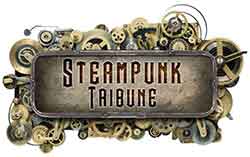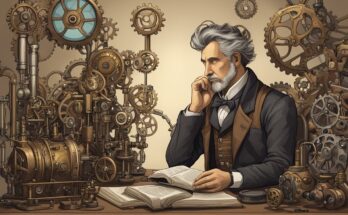“Here Comes Miss Banford”, by Keiiii
During the past few weeks, I’ve had to engage in a bit of a retrospective regarding how exactly Steampunk is defined. Fortunately, I’ve had an opportunity to speak with numerous individuals to ascertain their perception and ideas (both in RL and SL), as to how it is viewed. As seen many times in the past, there are numerous versions and opinions of it, and though it isn’t’ exactly splintering divergence, it may be seen that some gradients are certainly emerging.From its earliest inception, a single direction for Steampunk has been elusive, with some using the works of Verne, Wells, et al…, as a spring board, while others adhere quite ardently to a specific view or atmosphere provided by the concept of Steampunk. After further reading of the comments of the SteamCon book circumstance, I raised an eyebrow when someone made what might be seen as a snippish comment towards the very genial Mr. Foglio (the author, along with Mrs. Foglio, of Girl Genius), stating that …Girl Genius isn’t Steampunk at all, but rather Gaslamp Fantasy (by The Lost Vikings of ROACH). A bit of hair-splitting, as it is quite an enjoyable read with plenty of the genre-specific items which are Steampunk (e.g. steam-power, airships, ect…), but I did wonder, what exactly is considered Steampunk? What better way than to ask (via a poll)?In an attempt to provide a somewhat level handed choice as to the possible categorizations of the genre, I’ve used two sources for making selections in the poll the Steampunk Wikipedia, (http://en.wikipedia.org/wiki/Steampunk )and a particularly colorful thread from the New Babbage Ning, listed here: http://newbabbage.ning.com/forum/topics/the-old-new-babbage ? (Its a bit lengthy, but it does show the passion and division involved with the differing perceptions of Steampunk). As a basic premis, one aspect of Steampunk that all variations would have to have is a dependence on alternative technologies applicable to the Victorian era (e.g. steam-power for energy propulsion, clockwork “Steampunk Zoe”, by ZoeSteadI am forwarding a few categories as examples, but first, a disclaimer. They are not rigid definitions, only conceptual ideals, so please, while discourse and civil debate is highly encouraged, I would ask readers not to engage in dogmatic arguing regarding the definition of Steampunk, or attempt to start a an uncivil episode everyone has their opinions, and I (and possibly many others) are curious to learn of said ideas. Additionally, if the groupings do not sufficiently describe your view of Steampunk, by all means feel free to extrapolate in the comments! Enough of my prattling, on with the poll, and the choices… “Motor Unicycle”, by anicmanClassic (Working Class) Steampunk A version of the genre known known for its resemblance to working-class England, with touchstones of old, sooty working-class neighborhoods and an underlying sense of class tensions, which tie into a storyline. Though not as grimy as many other Steampunk stories, Steamboy does reflect the interaction between class conflict and technological progress. Though its story is a bit simplistic, it does provide a good example of the context often mentioned within many working class Steampunk stories.Aesthetically, one would see grime and grit, showing age and use in their appearance. Some examples of this might could be the environments envisioned in The City of Lost Children, Lemony Snicket, and of course, the aforementioned Steamboy.http://en.wikipedia.org/wiki/Steampunk “Steampunk Madam at Ohayocon ’09”, by yayacosplayScientific Romance (“Upper Class”) Steampunk
To quote the wiki entry on Steampunk… …writers tended to minimized the role of individual “heroes”, took an “evolutionary perspective”, held a bleak view of the future, and had little interest in space as a new frontier. Regarding “heroes”, several novels by H.G Wells have the protagonist as nameless, and often powerless, in the face of natural forces.and additionally…. The modern use of the term might superficially seem related to the rise of the “Steampunk sub-genre, but there are notable differences between the two: modern “scientific romances” typically take a distinctly more nostalgic or romanticized view of the era than Steampunk, and also often involve the future rather than the past, albeit a future based on Victorian or Edwardian sensibilities. Modern Scientific Romances are not of any form of “punk” or cyberpunk. Many of first contact that seasoned individuals have is with the literary classics Verne, Wells, and their contemporaries. As outlined, the emphasis is less on class tensions, and more focused on grander exploits on exotic machines (e.g. airships, submersibles, time machines). Aesthetically, one needs look no further than classic Hollywood movies (e.g. 20,000 Leagues under the Sea, The Master of the World), along with some newer movies (e.g. The Golden Compass, The Adventures of Baron Münchhausen) to see what could be perceived as the visual background for Scientific Romances.http://en.wikipedia.org/wiki/Scientific_romance “Steampunk Mouse”, by the Human FlyGaslight Romance (also known as Gaslamp Fantasy)
Again, to mention the subjective font of wisdom known as the Wiki, regarding Steampunk… …”steampunk stories are most commonly set in a romanticized, smoky, 19th-century London, as are Gaslight Romances. But the latter category focuses nostalgically on icons from the late years of that century and the early years of the 20th centuryon Dracula, Jekyll and Hyde, Jack the Ripper, Sherlock Holmes and even Tarzanand can normally be understood as combining supernatural fiction and recursive fantasy, though some gaslight romances can be read as fantasies of history.The genre would seem to mix elements of Working Class Steampunk and Scientific Romances, but the inclusion of notable era fictional characters and inclusion of supernatural elements separates it from its other ilk. Possibly, the most notable example of Gaslight Romances is the Girl Genius comic series, with an extensive background in this sub-genre of Steampunk, found at:http://www.girlgeniusonline.com/index.php Western SteampunkA differing aspect of Steampunk, it is most notable for taking place in the American West. First envisioned in the classic 1960’s TV series The Wild, Wild West, it has been revived at times in popular media (e.g. The Adventures of Brisco County, Jr., the re-make of The Wild, Wild West). It is most noted for its transition from an urban setting to a western setting in the United States during the mid-to-late 1800s.“Clockwork Steampunk Fly 1” by CatherinetteRingsFantasy Steampunk
The most notable difference in Fantasy Steampunk is the introduction of the concept of magic with in the technological context of the background. The use of spells, potions, and their ilk are combined with the basic technological background for Steampunk. IMO, this incarnation as listed in the wiki seems more Fantasy with Steampunk, but some well known example of it are Perdido Street Station, and The Scar.Other Variants of SteampunkThough a few more varieties are listed (e.g. SteamGoth, ClockPunk), I’m not quite sure of their popularity or view by most who follow Steampunk, so I settled them into the Other category, in case there are other areas of Steampunk that are pursued.So, if one has a preference, feel free to vote on the sidebar, and if there is some further explination is required, please feel free to do so!(Also this provides an excellent opportunity to display some excellent Steampunk works from Deviantart please do pay the artists a visit!)



